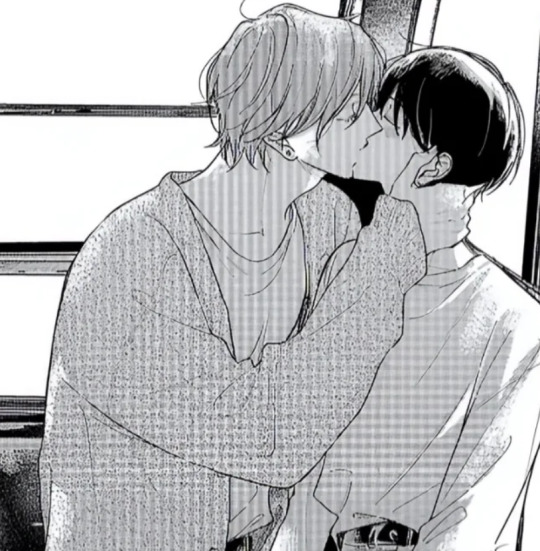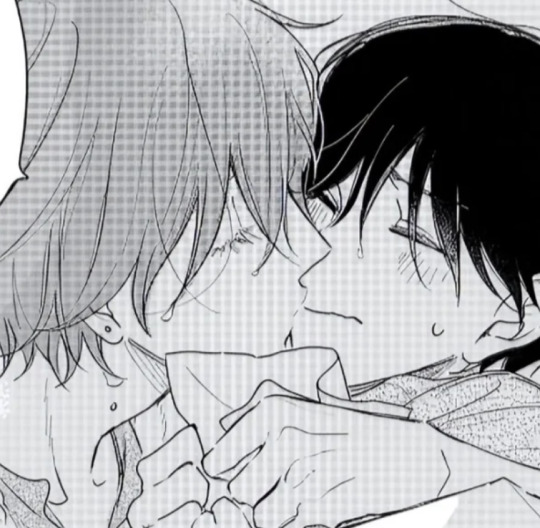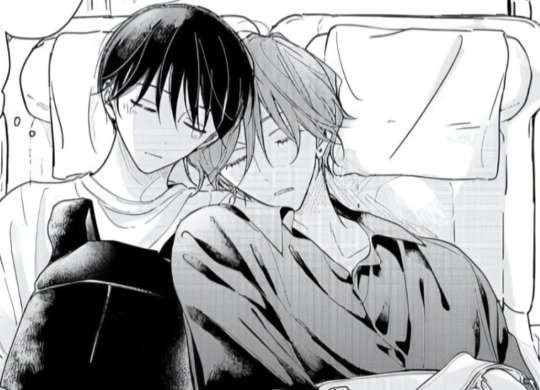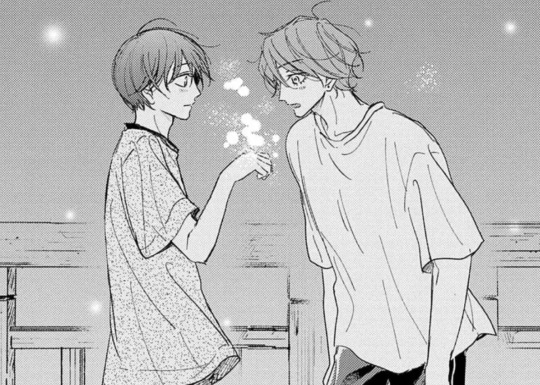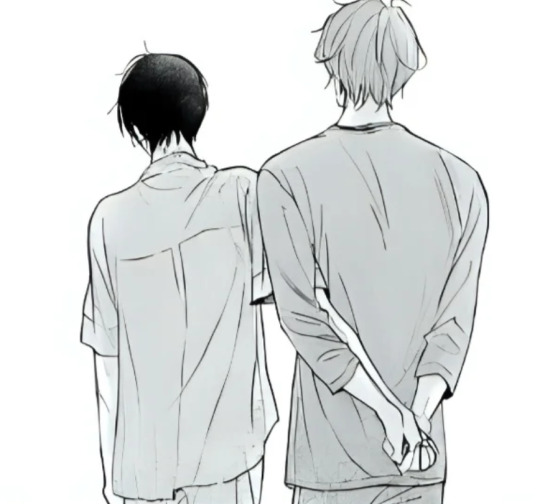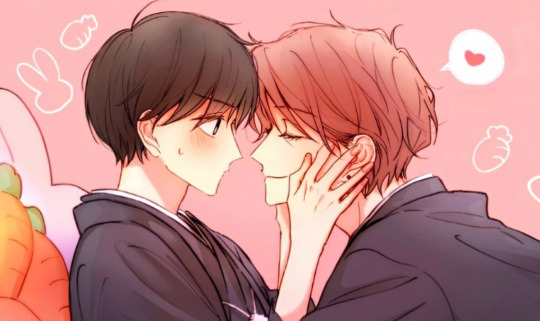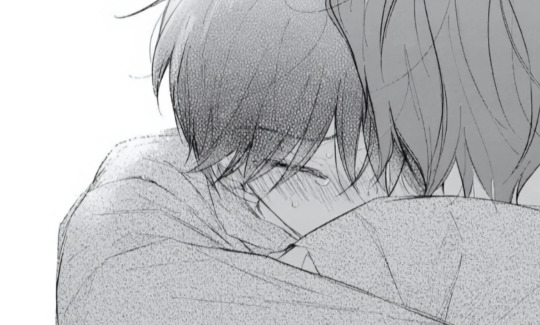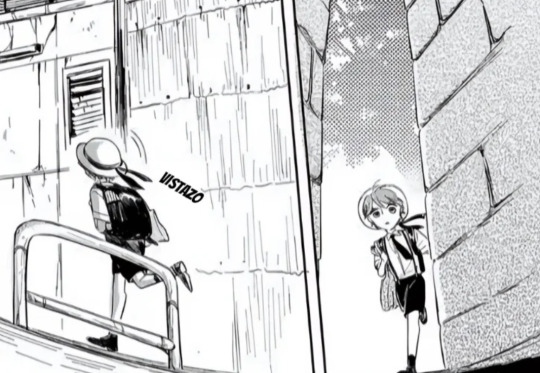Miraculous fan|Anime|manga|K-popYour local miraculous manga stan|she/her🗣️🇮🇹🇺🇸📚🇫🇷🇧🇷🇪🇸Instagram:jadenerd_|Tik tok:adriensimp_bot|Twitter:jad3_nerdAdrien Agreste no.1 stan|books and cats loverJust a professional simp|attending a catering and hospitality school|BL reader|Manga/Manhua/Manhwa|Danmei|Novel reader
Don't wanna be here? Send us removal request.
Text
Spring 2025 anime, Pt. 2: Just the Gems
hey, this post is also available on my ko-fi, so please check it out and consider tipping/donating as this is a labor of love. part 1 is here, and all of my seasonal reviews and end-of-year rankings are on my ko-fi and under my anime reviews tag, mixed in with my occasional musings. thanks!
Man. Good season for anime. I've got a lot to cover (and some new stuff to start watching for the summer season already), so let's not waste any time getting right into:
The Gems
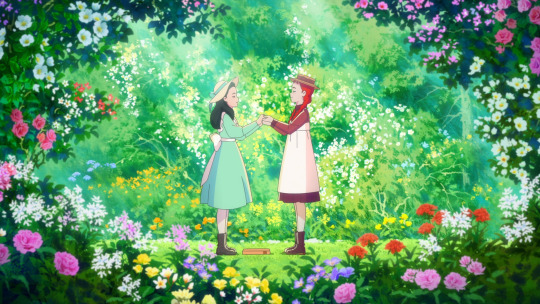
Anne Shirley
Anne of Green Gables is a big deal in Japan. L.M. Montgomery’s seminal 1908 novel was a hugely influential piece of western literature in postwar Japan, even being added to the national school curriculum in the ‘50s. Prince Edward Island remains a popular tourist destination for Japanese fans of the book series and its adaptations. And most relevant to what we’re discussing today, a massively successful anime adaptation in 1979, directed by Isao Takahata and laid out by Hayao Miyazaki, would cause ripples throughout the industry as it became a foundational piece in the founding of Studio Ghibli. It’s Kaguya Shinomiya’s favorite anime!
Another anime retelling of Anne of Green Gables probably wasn’t necessary, but in the age of animated pastoral escapism, Anne Shirley is welcome all the same. Slated for a two-cour run spanning the first three novels in the series, we’re rushed through the first book in just a fraction of the time the ‘79 anime took. We largely hit the same major beats: Unmarried siblings adopt a child, only to find out it’s a precocious redheaded girl instead of the boy they asked for, but she charms her way into their hearts, makes lifelong friends, and gets into a whole lot of wacky antics on her own whims. It’s fun, it’s heartfelt, it’s Anne of Green Gables. It’s considered a classic over a century later for a good reason.
Anne herself is beyond delightful. She’s an absolute force of personality and earnest to a fault; speaking like a literary heroine but meaning every single overwrought word. She’s bright and expressive, and she feels everything very deeply to the point of stubbornness. She falls in love at the drop of a hat and holds grudges for years. Her youthful misadventures are a blast, even when she gets herself in trouble and acts like it’s the end of the world every single time. Honoka Inoue put in tremendous work making such an iconic character her own.
I can appreciate that in an era where major anime releases can make splashes by aping older animation styles (and I’ll get to a couple of those shortly), Anne Shirley doesn’t let itself linger in Takahata’s shadow and insists on being its own thing. Even as a period piece (with perfect localization to boot; the subtitles are rife with rustic Victorian English) and as a remake of classic literature and anime alike, this show still slots in perfectly as a piece of modern iyashikei. The setting is lush and gorgeous (and as some quick research showed me, plenty faithful to the real-life setting in Cavendish), the color palette vibrant and saturated, and the character animation expressive and often intricate.
So, uh, I haven’t read Anne of Green Gables nor watched the original series, so I’m in no position to comment on the heavily-abridged retelling of the books, but at no point did I feel like I missed anything. The book series depicts the entirety of Anne’s life beginning at the Cuthberts taking her in, and because the entirety of the first book is adapted into a scant ten episodes, months can pass in the blink of an eye. Watching her grow is immensely satisfying, just as I’m sure it felt for Matthew and Marilla, and watching them grow along with her (ESPECIALLY Marilla) has been my weekly salve every Saturday. The emotional core is extremely strong here.
This series is continuing into the summer season, and if it keeps pace without breezing too hard through the next two books, it has the chops to contend for anime of the year. There’s nothing wrong with returning to the classics, and Anne Shirley lives up to its namesake with similar aplomb.
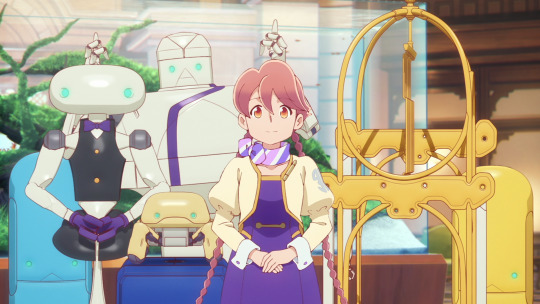
Apocalypse Hotel
I had next to no interest in this show until I found out that CygamesPictures was animating it. If the studio that gave us Bang Brave Bang Bravern last year and secured the rights to adapting contemporary manga hits like Kagurabachi and The Summer Hikaru Died was investing its parent company’s gacha money into another original anime, I had to see what was up.
Holy shit.
Over a century after humanity evacuated Earth to escape an airborne virus that threatened to eradicate all primate life, the Gingarou Hotel in Tokyo’s ritzy Ginza district is humming along. Overseeing the hotel’s day-to-day is Yachiyo, a humanoid concierge robot taking over as the acting-acting manager in the stead of the proprietor who fled to space 130 years ago. The massive hotel’s robotic staff has dwindled down to single digits, but Yachiyo is more than up to the task of overseeing the most minute details, from amenities to upkeep to offsite duties, in hopes of greeting the first guest in over a century. And she’s absolutely sure it’s gonna happen. Tomorrow does eventually arrive, though, in the form of a bizarre intergalactic traveler, who opens the door to a new possibility: If humans won’t be patronizing the hotel anytime soon, might as well open it up to the extraterrestrial. A family of tanuki dickheads soon make the Gingarou their (literally) shitty den, and after Yachiyo loses it on a guest for the first time, they make amends by helping make it the best hotel in the galaxy.
As silly as it is from the outset, the first episode of Apocalypse Hotel beat my ass on an emotional level. Watching Yachiyo carry out the same menial routine, day after day, in the hopes of seeing someone that may never arrive filled me with a profound existential sadness. There's a sort of hollow melancholy to it all, struggling to maintain normalcy on an abandoned earth, just going through the motions, and for nothing. It felt like watching a time-lapse of Hachiko waiting at Shibuya Station for an owner that would never return. I was reminded, as I often am, of NieR: Automata; seeing synthetic life carrying on on a ruined Earth in the image of humans that have all but abandoned it. A neverending proxy war is one thing, but seeing Yachiyo remove an untouched tablecloth and re-tuck the sheets on a bed that’s gone unoccupied for over a century just tore my heart out. As the series goes on, she continues to try to actualize the owner’s vision for the Gingarou, countless years after his all-too-certain death, even trying to carry out impossible tasks like singlehandedly building an onsen in an area that may not even have a natural spring. And for what?
There is both joy and melancholy to be found in this, though. What begins as an exercise in futile patience grows over an unknowable timeline into a rumination on the virtues of said patience and the beautiful things that can come from it (namely whiskey). Because the cast is composed of robots and barely-aging intergalactic beings, decades and even centuries can pass in the blink of an eye. Across this span, though, the only constant is change, and amidst an infinite universe and a seemingly infinite (and occasionally inconsistent) timeline, there is no end to what this show can bring; not just a galaxy or two’s worth of undiscovered life, but unexpected kinds of happiness and grief as well. Loss is inevitable, but so is new life, even when humans are long gone. As she gets further outside of her comfort zone beyond what she was programmed to handle, Yachiyo finds herself acting much more human; she can lose her temper, resort to violence, and even experience an existential crisis, as we all do. As it turns out, though, these were all Easter eggs embedded in her programming, and each time she finds herself doing something a service worker frequently does (like drinking the aforementioned whiskey) or wishes they could do (like punching a customer), it unlocks a cute little extra program in her system, like spraying confetti or turning her into a hot babe.
This juxtaposition of the wistful and the absurd makes Apocalypse Hotel one of the most unpredictable shows I’ve ever seen. I was a fool to think Cygames had run out of “are you fucking kidding me” moments after Bravern, because this show threw curveballs at me week in and week out. It’s almost obnoxiously creative, and there’s little I love more than when you can tell that everyone involved went “oh, right, we can do whatever the fuck we want here.” One week could bring a completely left-field action setpiece, a bizarre romantic tease in the next, maybe then a tense cat-and-mouse thriller, and then you’re reminded at the worst possible time that the emotional blows weren’t relegated to the premiere episode. Hell, the ending of the show had me simultaneously laughing and crying, the latter mostly because I was genuinely sad to see it end.
With a limited permanent cast, Yachiyo and the tanuki daughter Ponko absolutely own this show. As an apology for her family being a pack of shitbirds, Ponko offers to help out Yachiyo in her management duties around the property, and she quickly becomes an indispensable part of the Gingarou and the show itself. For as much of a genki goober as she is, Ponko is there for Yachiyo in her best and worst moments, and Yachiyo is there for Ponko in kind. They bounce off of each other perfectly, and I would gladly watch six more seasons of just those two if that were ever possible. I would have never guessed a friendship between a service gynoid and a Bkub-faced tanuki child would move me as much as it did. Their respective voice actors are on point as well; Saho Shirasu is a revelation as the even-keeled but unpredictable Yachiyo, while Sumire Morohoshi (Emma in The Promised Neverland, Misaki in Maid Sama) perfectly embodies Ponko’s chipper but chaotic temperament. And with the settings, stakes, and subject matter constantly changing, they are always game to adapt to literally any situation.
And on a similar note, this show sounds terrific. Yoshiaki Fujisawa, composer for series like Mushoku Tensei, Land of the Lustrous, and A Place Further Than the Universe put in serious work highlighting the beauty and absurdity of Apocalypse Hotel in equal measure. One recurring track, usually used as the backdrop for exploration of the ruined landscape, called to mind old Pogo tracks from YouTube (remember Pogo?). The OP, Aiko’s “skirt,” is painfully fitting for the show; a beautiful but dissonant solo dance in the dark, for an audience of none, giving way to joy and community. The real masterstroke was a late episode, mostly devoid of context, in which Ponko forces Yachiyo to take a day off (labor laws still apply, after all) and take in the city for herself, in a long, ponderous stretch without a single line of dialogue. This whole show is a feast for the senses.
I haven’t even talked about how fucking great this show looks either! This is a really special one.
I could talk about this show for ages. I went in with no expectations and ended up loving my stay. Apocalypse Hotel is a serious contender for anime of the year, and I really hope more people catch word of it. Five stars.
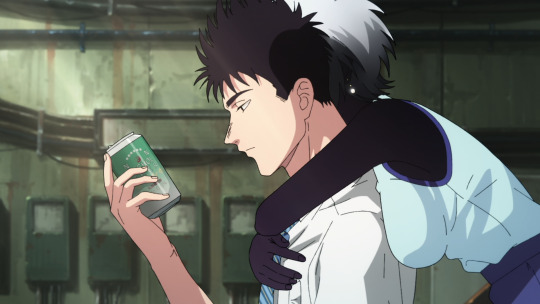
Kowloon Generic Romance
Nostalgia is a hell of a drug. It’s tempting to want to go back to the time when you were younger, when better things seemed possible, when you were happier. It’s a defining characteristic of our present time, for better and for much, much worse. You can call it escapism, you can call it arrested development, you can call it commodifying something that may have never actually been there, and you’d be right more often than you’d be wrong. If all you have is what you used to have, are you truly living in reality?
Kowloon Generic Romance ruminates on nostalgia in the most effective way possible by evoking a bygone style of anime that oldheads on Twitter continue to gush over. It fully looks like an early 90s production, from its angular, dare I say outdated character models, pastel and gem-tone color palette, and its luscious hand-painted backdrops. Its entire aesthetic, right down to the bubble-era Chinese fashion and the very fact that it’s set in Kowloon Walled City, makes you yearn for the days of that classic handmade quality. If not for the occasional use of CGI or the sudden prevalence of smartphones in its second episode, I might’ve actually been convinced for a minute that it was a 30-plus-year-old show. It’s incredibly on the nose that nostalgia, deja vu, and romance are key themes in this series, because the way this show looks and sounds elicited those exact same feelings in me.
Based on the nearly-completed manga by After the Rain creator Jun Mayuzuki, Kowloon Generic Romance centers around Reiko Kujirai and Hajime Kudo, a pair of Japanese real estate agents working together in Hong Kong’s Kowloon Walled City. Though the city is decrepit and overpopulated, Reiko and Kudo live a cozy, almost idyllic life, eating the same lunches, playing mahjong, and bickering like schoolchildren. While Kudo seems perfectly content with this life, Reiko wants to branch out a bit more: She’s made a new friend who recently moved into the city, she’s trying new restaurants, and above all, she’s fallen hard for the beefy idiot who works right behind her. Those feelings get a lot more complicated, though, when she finds a Polaroid of the two of them together with a written caption celebrating their engagement.
Reality is a tenuous thing in this twisting narrative, and at the center of it is Kowloon itself, which was famously torn down in 1994 and converted into a public park. How is such a relic of its time still standing in the era of smartphones? What past actually lies within its walls, and how is it impacting the present? What–and who–is actually real in here? Who was Reiko before now, and what was her relationship to this city? Kowloon Generic Romance’s story is constantly turning on a dime, its mysteries always multiplying and deepening. A bizarre pharmaceutical company with a strange snake-like man at its helm, the sudden disappearance of a waiter at Kudo’s favorite haunt, and the giant floating tesseract in the sky only complicate matters. What starts out as a romantic period piece seamlessly morphs into a sci-fi thriller where everything is in question.
The very concept of the “self” is examined quite a bit in Kowloon Generic Romance. Reiko is faced constantly with the question of who she is, who she was, and whom she could be; whether it’s at all possible to become her “absolute self,�� as is often repeated throughout. Her new bestie Yaomay (voiced pitch-perfectly by Aoi Koga, who put in serious work this season) is the perfect partner for her in all this, as she has a past she would prefer to bury in order to become what she always wanted to be. She changed her name and every last detail of her appearance in order to reach her own self-actualization, and she’s exactly whom Reiko needed to meet: Whereas Reiko sees herself as a walking facade, Yaomay sees the art in artifice and believes herself to be a literally self-made woman. It raises terrific questions about identity; at what point does acting aspirationally become your true self? Does outgrowing your aspirations strip you of your “self?” Can you truly have a “self” if you’re living for someone else, or worse, someone else’s downfall?
Not for nothing, but this show is fucking sexy. It’s not just that the characters themselves are plenty good-looking (and I must note that Yaomay and especially Reiko are two of the most attractive anime women I’ve ever seen in my life; they just don’t make ‘em like that anymore), the way they dress and carry themselves is just mesmerizing. Hell, just the first episode exemplified this: The opening scene is just Reiko smoking on her patio in her pajama shirt, and a later scene of her splayed out, sweating, exhausted from painting a hot room had me fanning myself. The onscreen romances and attempts thereof are magnetic. Mayuzuki just gets it. There’s also a good amount of time dedicated to a frankly-depicted gay relationship, a major character who is intersex, and another with a complicated relationship to gender expression. Sexy AND sexually progressive. Great way to cap off Pride Month.
Kowloon Generic Romance, as a television series, is very propulsive and can move from scene to scene rapidly, in no small part because it is an 11-plus-volume manga crammed into a complete 13-episode season. The story is told from beginning to what we can only assume is its canon ending, as Mayuzuki is likely still several months away from finishing the manga as of the anime’s finale. I read as much of the manga as has been translated into English after the halfway point of the season, and while the pacing is far more brisk in the anime, I’m happy to report that very little is actually lost in translation to the screen. Kowloon Generic Romance’s manga moves at a leisurely, almost sleepy pace, and while the anime doesn’t have quite as much time to luxuriate in its established vibes, they’re still very much there. Some scenes and flashbacks are told in different order, we see less of Reiko’s friend Xiaohei seemingly working every odd job around the city, and some of Kudo’s hobbies like mahjong and patronizing a porno theater are either downplayed or cut out entirely (the scene I used as a header took place in said theater in the manga, for instance). For efficiency’s sake, I can’t say I mind too much. I struggle to think of how we could’ve gotten a better adaptation than this.
I’m stuck between this and Apocalypse Hotel as the anime of the season, but I’m leaning towards this one ever so slightly. And at the halfway point of 2025, I’m comfortable calling Kowloon Generic Romance the anime of the year so far. The summer season is insanely stacked, so it could quickly and easily be dethroned, but my memories of this show will always be fond ones.

mono
I knew nothing about this one going in other than that it was an adaptation of another manga by Yuru Camp creator Afro. What I didn’t expect was just how much Yuru Camp is still in this: Though plenty of the hit series’ DNA is evident in mono, I wasn’t expecting to see its fingerprints all over it as well. If you’ve been dying for more Yuru Camp since the end of season 3 a year ago, you can do a hell of a lot worse than this.
mono follows Satsuki, an amateur photographer who mostly just joined her high school’s photography club to take pictures of her senpai, and An, who joined the same club just to take pictures of Satsuki taking pictures of their senpai. When said senpai graduates, though, Satsuki is left in a bit of a rut. An suggests they carry on her legacy, and they agree to get cameras of their own: Satsuki gets a 360-degree camera for landscapes, and An orders an action cam off of eBay, which… never shows up. The girls manage to track down the seller, whose address turns out to be a dagashiya housing Haruno, a mangaka, whose editor is asking her to write a new manga about high school girls (and also a free-roaming cat named Taishou, who rules). Seeing a perfect opportunity, she offers to help the girls out with their club in exchange for letting her base the series on their escapades. In order to stave off being folded due to a lack of membership, the photography club merges with the similarly tiny cinema club, helmed by the sleepy-eyed, enigmatic Sakurako, and the Cinephoto Club is born.
It’s pretty easy to write mono off as a little too meta and self-referential for its own good, especially as far as Haruno is concerned, but Afro’s work is so characteristically charming that I didn’t really mind. It’s much more of an outright comedy than Yuru Camp; it exhibits the snappy timing of a gag series from the outset, but it soon falls into a more familiar iyashikei rhythm once Haruno-sensei starts chauffeuring the girls around Yamanashi (seriously, whatever their tourism board is paying Afro, they’re getting their money’s worth). Yuru Camp’s shadow looms large over this series, but its success is so intrinsic to what mono is that I can’t help but do the Leo point when we see the odd Rin Shima cameo or pinecone saying “konnichiwa.” It also has just enough in common with other iyashikei-flecked slice-of-life series like Dagashi Kashi and Insomniacs After School that it feels like its own thing; Afro likes diving into the little things they cover, so we get to learn bits and pieces about photography, architecture, local history, and even booze. It’s like going on an educational trip every Saturday.
While they’re no OutClub, mono’s cast definitely carries the show. Sakurako is a likable enough protagonist, but the rest of the club really shines here. An, voiced by Aoi Koga (at this point one of my favorite VAs), is delightfully genki and far too silly for her own good, and the mush-mouthed Sakurako, voiced by Hikaru Tono (Anna in last year’s Makeine), is full of surprises, whether it’s a bottomless stomach or seriously impressive bug impressions. Haruno (the always wonderful Reina Ueda) and her gal pal videographer Kako are a great time as well, and much like in Yuru Camp, it’s fun watching different permutations of these ladies get together and trek for local eats. But we all know Taishou is the real protagonist here.
This is the debut production from studio Soigne, and they absolutely crushed it. Though the studio had no hand in Yuru Camp, they did a bang-up job of imitating a lot of the same look and feel while still setting mono apart as its own thing. Hell, one look at Satsuki and An’s triangular brows and you immediately know it’s an Afro production. It’s definitely riding on Yuru Camp’s cache a bit in some places, especially the OP, but the animation style is much looser overall, especially in the episode where Haruno gets shitfaced at a wine tasting (with an obligatory Toba-sensei cameo to boot). The studio also has plenty of fun playing around with stylistic switch-ups, from an Initial D-esque downhill race to occasional forays into horror thanks to one of Haruno’s mangaka buddies. If anything, mono feels like Yuru Camp without the guardrails, and it’s been a blast to see what direction it might take next.
Watching Yuru Camp isn’t a prerequisite to your enjoyment of mono, but it certainly helps, and if you’re already a fan, it’s a lovely companion piece with a ton of Easter eggs for your enjoyment. On its own, it’s a plenty enjoyable iyashikei slice-of-life and an easy recommendation for a cozy weekend. I want some shaved ice now.
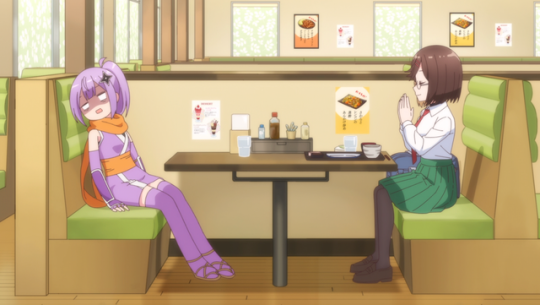
A Ninja and an Assassin Under One Roof
Here’s a curious production by Shaft: The same studio known for high-value anime productions like Madoka Magica, Nisekoi, and the Monogatari franchise took up the mantle for this oddball yuri dark comedy about, well, [gestures at the title]. You’d probably never know it if you didn’t look it up for yourself, but some fun wrinkles are thrown into this happy gay murderfest as the blood flies and the bodies fall.
NinKoro, which I’ll be calling it for short from here on out, follows the misadventures of Satoko, a doofy kunoichi who managed to escape from her ninja village to the city, and Konoha, a high-school-aged assassin-for-hire who saves her from a ninja pursuer. Satoko thanks her by cleaning up the crime scene using her unique ninjutsu that can turn any object into a pile of leaves, and Konoha sees an opportunity for partnership. In exchange for taking Satoko in, Konoha enlists her help cleaning up her murder scenes for a cut of her earnings as she climbs the assassin rankings. Satoko also cooks. And cleans. And shops. And sleeps in the kitchen. But she’s such a happy-go-lucky dingdong that she doesn’t seem to mind, even as she puts everyone in their orbit in certain danger as more ninjas track her down, but Konoha’s always there to put them down. See, it’s a symbiotic relationship!
The character growth in this was the part that really compounded my increasing enjoyment as the show went on, because not for nothing, Konoha straight up SUCKS for like the first half of this show. She largely ignores the eager-to-please Satoko and just sits around on her bed staring at her phone all day when they’re not working (unfortunately, same). She understandably has her walls up as an assassin, but sometimes I just feel bad for Satoko, even as it’s played for jokes. There’s an early tease of vulnerability in the terrific episode where she gets along better with a robot stand-in for Satoko than she ever had with the genuine article, which feels even crueler when the real one comes back, but patience is plenty rewarded in the back half of the season. We get some good old-fashioned Yuri Yearning as the show goes on, too. I’m particularly impressed with the fact that although this is nominally a gag series, NinKoro is surprisingly committed to its own progression and isn’t afraid to build on itself, with even minor joke details coming into play in unexpected ways later on. This is a much smarter show than it lets on.
The cast, and more specifically the casting, carry NinKoro a long way. Haruna Mikawa (Satsuki in the aforementioned mono and Sung Jinah in Solo Leveling) is an absolute blast as both Satoko and her robot analogue Roboko, and the living legend Kana Hanazawa, who also performs the OP, nails Konoha’s cold, sardonic demeanor. The will-they-won’t-they between them is largely played for laughs for a while, but their chemistry genuinely builds as the series goes on. The pair’s rival-turned friend, the mad inventor assassin Marin (perfectly voiced by I’m in Love With the Villainess’ Yu Serizawa), is a blast every single time she’s on screen, if for no other reason than the fact that she continues to put up with Satoko despite being completely fed up with her shit. Satoko’s butch ex-ninja friend and her girlfriend are also great and usually willing to help, even though they’re constantly being put in harm’s way.
As enjoyable as NinKoro largely is, I did occasionally find it at odds with itself. Though its sense of humor is plenty dark, and I do enjoy dark humor, its subject matter seems needlessly cruel sometimes. On occasion it’ll bookend an episode with a flashback to the newly-dead ninjas planning out their futures together or lingering shots of their now-empty homes. I can appreciate that the series reminds us that Konoha’s wacky, silly executions do indeed have a human cost, but for a while it seems like it’s just taunting us for laughing, and to what end, I’m still not entirely sure. It never seems to go anywhere except for occasional scenes in an afterlife where all of the slaughtered ninjas get to see each other again, and though it does partially give us a (very silly) plot point, I really don’t know what the point of those early “hey these people are DEAD” scenes were other than to make the viewer feel bad. There’s such a gulf between the comedy and the darker elements that it inflicts some serious tonal whiplash.
What really compounds my bafflement with this being a Shaft production is that Madoka director Yukihiro Miyamoto was also tapped to direct this. While the whip-fast gag pacing is tremendous in NinKoro, it doesn’t feel like anything particularly special about 80% of the time; it comes across like a pretty straightforward, decently-animated slice of life. That remaining 20% is where it shines, with wildly well-animated sequences of new ninja introductions right before Konoha swiftly and mercilessly cuts down yet another one. Satoko’s introduction at the start of the show is brilliant; it looks like it was perfectly ripped from an 80s animation. There are also some very intricately-animated shots of girls’ hands touching and caressing each other. I mean, obviously, this is a yuri series. Don’t think I didn’t notice.
I was mixed on NinKoro for a while, but it really found its footing eventually and became a genuinely enjoyable watch. It’s likely that this show is done after just one season, which is the sad truth for most yuri series out there. It’s a shame, but I ended up surprisingly satisfied with what we got. As gay dark comedies go, you can do a lot worse.
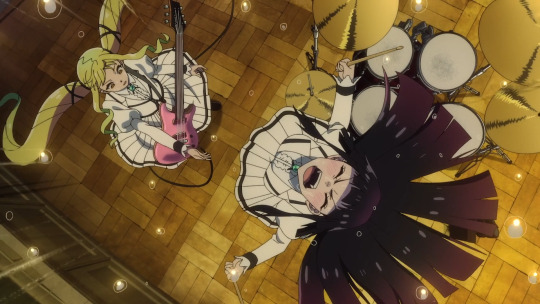
Rock is a Lady’s Modesty
Yuri bait is a time-honored tradition in girls’-band anime. You get a bunch of young women together in one place in a pressure-cooker environment like making music and you’re bound to see a lot of emotions flying and hormones pumping. There are so many lingering looks and fawning comments to pore over, so many definitely-not-romantic confessions to debate endlessly, and so many lyrics to decode through a lesbian codex. It’s an art, just as much as the series themselves and the music that comes from them, to pick up and devour any possible crumbs of girls’ love within these fictional bands.
Rock is a Lady’s Modesty, meanwhile, does away with all that coward shit and gets mega gay with it.
Lilisa Suzunomiya’s mother married into an extremely rich family, which granted her access to a similarly prestigious all-girls’ private high school. Though she comes from a more modest upbringing, she’s fitting in pretty darn well! She is the absolute picture of ladyhood, carrying herself elegantly and performing well in class, and most importantly, the other girls adore her. Lilisa is sure to mind her P’s and Q’s at all times so she can attain the school’s top honor of Noble Maiden, proving she’s the paragon of ladyhood, and beat all these rich bitches at their own game by showing that she and her mother belong in high society.
Problem is, acting prim and proper like this has Lilisa feeling a little pent up: Her father, who is no longer in the picture, taught her how to play guitar, and she’s gone without that outlet for some time now. One day, she stumbles upon the school’s old building, and in its music room she stumbles across a classmate, the beautiful Otoha, going apeshit on a double kick drum. She immediately sees through Lilisa’s facade and encourages her to grab a guitar and play with her, only to completely overpower Lilisa’s playing with her loud, propulsive drumming. Lilisa gets frustrated, but she relishes a challenge, so she starts shredding to keep up, and Otoha responds in kind. By the time they’re done, they’re both so sweaty and adrenaline-high that they can only start screaming at each other, hurling vulgar abuse back and forth until they’re both satisfied. And so begins a beautiful friendship.
Lilisa’s caught between two worlds, and she’s able to channel her frustrations through music. There’s plenty to be said in Rock Lady about finding your identity through music, and the class struggle she’s found herself in plays a massive role. Spite is one hell of a motivator, especially when it comes to making music, and when rocking the fuck out isn’t enough, sometimes you gotta just scream at someone like a delinquent. The two bandmates they gain, school “prince” Tina and icy ronin guitarist Tamaki, are dealing with struggles of their own, and need a lot of time and practice before they feel comfortable with their roles in the band. They have their own issues to sort through, but dedicating their time to the music, finding their own niches, and just feeling it out go a long way towards their self-actualization.
Though I haven’t seen it explicitly tagged as such just about anywhere, Rock is a Lady’s Modesty is 100% a girls’ love series, arguably more so than NinKoro. The dialogue between Lilisa and Otoha is Bravern-esque in its excessive innuendo to the point where both entendres might as well be the same thing, and the musical interplay between them is straight up depicted as TV-safe BDSM at times when they’re at odds. And this show is SO fucking sweaty. Even putting the sexually-charged language (and occasional imagery) aside, it’s kind of impossible not to look at Rock Lady through a queer lens; the girls’ relationships to each other, their music, and their social obligations can be read as pretty clear allegories just beneath the surface. So many of their character arcs are about living as one’s true self, bucking conformity, and defying traditional expectations of being ladylike in order to do what they love. The band’s commitment to performing fully-instrumental music when everyone else, bands and audiences alike, put vocals on a pedestal, can be read as an obvious metaphor as well. Everyone’s internal conflict is about repressing the irrepressible for the sake of fitting in, to the point where you can replace “rock” with “WLW” in like half the dialogue and you’ll basically get the same meaning. I mean, come on, Lilisa’s stage name is Lily, which is, of course, English for “yuri.” And this yuri, too, is rock.
The music, it should go without saying, fucking rips. I was already made an all-too-late fan of BAND-MAID by the OP to last season’s excellent Zenshu, but the band is inextricable from what makes Rock Lady a hit: Not only did they crank out another screamer for this show’s terrific opening, but they contributed both the music and the motion capture for the girls’ performances. The terrific ED, by pop vocal group Little Glee Monster, probably would make me roll my eyes if an English analogue played at the grocery store, but it works really well here. The actual diegetic music dies out a bit in the middle episodes of the show (and frankly the plot sags along with it), but that drought is ended as the band gets together in earnest and the story ramps up towards its explosive, dare I say climactic, finale. I did think it was funny that the western bands Lilisa cited as her influences were Led Zeppelin, Linkin Park, and the Red Hot Chili Peppers (yeah, me too, when I was 12) when the actual music sounds nothing like any them, but that’s just me being a snob. What counts is what we got, and I’m sure the mangaka is plenty happy.
The CG motion capture for the girls’ performances is… fine. It’s kind of like in Medalist where it’s cordoned off just enough from the rest of the show that it registers as its own thing, but also like in Medalist, it’s just good enough that I’d have been happy if the whole show looked like that, or like a cel-shaded Girls Band Cry. The regular animation is plenty great and rife with visual gags and metaphors that really play up the GL “sub”text, but the real treat is when Lilisa and Otoha get whipped up in their post-music fervor and their character models turn all snarly and sketchy, like they got plucked out of a Trigger animation. If the whole show looked like that it might be closer to perfect, but the switch-up is so much fun I found myself looking forward to it just as much as the music that always precedes it.
While the band’s growing pains in the middle of the season dragged the narrative down for a couple episodes, I’d still say Rock Lady is a winner and one of the better anime I’ve seen so far this year. Rocking out with your cock out isn’t limited to sex nor gender, and these ladies have fully whipped ‘em out. Get your lighters and middle fingers up.
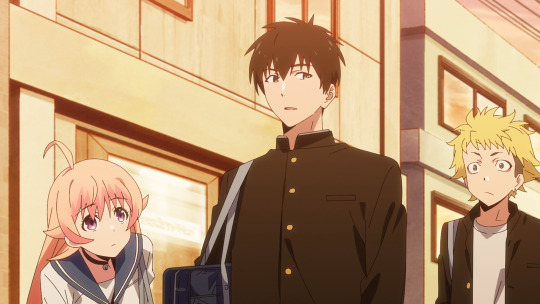
Witch Watch
This is a series I constantly see on the Manga+ app and had heard next to nothing about, but I was interested when the anime was announced. An enthusiastic recommendation from a friend put it on my must-watch list, and it’s been a pleasant surprise all season. A funny, cute slice-of-life is like catnip for me, so I’d happily pass that recommendation along.
Nico Wakatsuki, a high-school-aged witch, moves back to her hometown to reunite with her childhood friend, Morihito Otogi, an oni, in order to take him on as a familiar and a bodyguard. Morihito (whom Nico very cutely calls Moi-chan, because his name was hard for her to pronounce as a kid) takes her into his home right as his dad conveniently leaves for an indefinitely-long work trip, which makes things very interesting because Nico is secretly head-over-heels in love with him. Along with her other familiar, the Kansai tengu Kanshi, Moi is determined to prevent a prophecy delivered to him in secret by Nico’s mother to ensure disaster doesn’t come her way. Hilarity ensues, and perhaps romance as well.
A gag series surrounding a dim, clumsy witch-in-training is an endless fount of comedy, and it helps that the cast surrounding her is just as charming. Morihito makes a great tsukkomi to the constant insanity surrounding him, but it’s just as entertaining when he drops the act to reveal that in plenty of ways he’s just as much of a goober as his friends are. Kanshi is a total riot, never taking just about anything seriously, and the chaotic energy between him and Nico is irresistable. Keigo’s kind of a drip, but he’s been a rewarding character to get to know. I’m hoping for more of Nico’s friends in class, Kara and Kukumi, if only because they’re voiced by Rie Takahashi and Konomi Kohara, and their closet-otaku homeroom teacher is dropping HxH and Demon Slayer references left and right. I could keep going.
And although this is a gag series at its core, Witch Watch does have some serious heart. The central romance plot, slow-burning though it is, is just compelling enough to string me along, even if this ends up being on some Nozaki-kun shit and going nowhere forever. Nico and Moi are cute as hell together, and I love that despite him being an outwardly serious, stoic guy, Morihito very clearly cares a lot about Nico. I’m rooting for those crazy kids. It’s also sweet seeing Nico employ her magic powers to help people with very real problems, and her willingness to genuinely help improve their lives makes her an easy protagonist to root for, even if she’s equally prone to causing disasters.
Bibury has done a fine job with this show. It looks solid just about all of the time, but the production’s strength is in how well it matches the manic pacing of adapting a gag manga (I like to think 100 Girlfriends’ success is what got the studio the rights to this one). The manzai pacing of the dialogue is great, and the production team is always game to go in different directions for the sake of a joke, like Kanshi stuck operating at 10x speed or Nico helping a lovelorn classmate who looks and acts like he came from an English textbook. I can see why the source material has been running for over 200 chapters, and like with 100 Girlfriends, I can just as easily see the studio being in this for the long haul.
I gotta speak my truth here: This show has one of the best OPs I’ve ever seen. YOASOBI’s “Watch Me!” is an earworm, to be sure, but even above that, it looks fucking stellar. The muted linework, soft color palette, and freakishly fluid movement reminded me immediately of recent One Piece OPs as well as Fan Letter, and wouldn’t you know it, it was directed by the very same Megumi Ishitani that was behind exactly those. It’s mesmerizing to look at. Even if I wasn’t already enjoying the show, I’d have kept up with it week in and week out just to catch the OP every time. There was even a surprise flex in just the third episode that was presented as Nico accidentally breaking the whole thing down to its key animations, which not only still looks insane but is apparently also hiding some Easter eggs from the mangaka's previous work, Sket Dance. I have no hesitation in saying that “Watch Me!” belongs in the same conversation as contemporary instant-classic OPs like “99.9,” “Daddy! Daddy! Do!,” and “Bling-Bang-Bang-Born.” YOASOBI can’t keep getting away with it.
I was surprised to learn that Witch Watch is continuing into the summer season, and although I suddenly have a ton on my plate with nearly a dozen prominent anime continuing and coming back in July, this show’s going to continue to be a great palate cleanser. I’m not totally enchanted yet, but I’m looking forward to seeing it continue to work its magic.
159 notes
·
View notes
Text
Sometimes you gotta say “damn”, and then return to scroll

2 notes
·
View notes
Text
In the end…I watched it.
I watched it 2 weeks ago and of course the animation deserved more justice.
BUT I MISSED THEM SO BAD YOU DON’T UNDERSTAND-
I really want to continue the anime of requiem of the rose king as if I don’t have hundreds of anime to finish
even if the quality is not good. I’ll never forgive them for doing that to this masterpiece
1 note
·
View note
Text
MY SHEILAAAA


11 notes
·
View notes
Text

EVERYONE WATCH THIS MOVIE IT IS SUCH A MASTERPIECE
8 notes
·
View notes
Text


Anyway I make silly duckies, everyone be nice to them
0 notes
Text

im so glad we can have family time in the kitchen in this specific spot. where nothing weird has happened.
3K notes
·
View notes






















